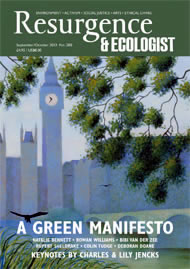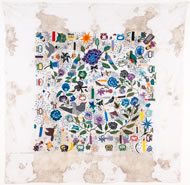In Ottawa last May, the director of the National Gallery of Canada inaugurated its largest and most ambitious exhibition to date – entitled Sakahàn: International Indigenous Art – with the hope that it would ‘change the world’. In the Algonquin language, sakahàn means ‘to light a fire’, which seems an apt title for an exhibition determined to set the contemporary art world ablaze with the first major display of works by 82 indigenous artists from six continents. The result of four years of careful planning by three North American curators, this exhibition succeeds in breaking the many still-prevalent preconceptions and stereotypes of what ‘indigenous’ arts should be.
The idealisation of ‘primitive’ peoples – who live close to Nature and thus are imagined as pure and noble – has been traced back to antiquity by such Western scholars as Arthur Lovejoy, Ernst Gombrich and Raymond Williams. Yet such romantic notions are vigorously rejected by one of the most strident artworks in the Sakahàn exhibition: a large acrylic painting featuring a brightly coloured target-like background overlaid by splatters of black and white and the bold sign-like text “I AM NOT A NOBLE SAVAGE”. The artist, Richard Bell (an Australian Aboriginal), explains in the painting’s extended label that it “relates to the misrepresentation and oppression of indigenous people in Australia and the world. […] We are only ‘authentic’ if we are living ‘traditionally.’ Otherwise it is deemed we have lost our culture. This view condemns indigenous people to poverty by segregating us and framing us as primitives with no place in contemporary life. If we cannot be both ‘indigenous’ and ‘modern,’ then we are doomed to extinction.”
The theme of dual indigenous and contemporary identity recurs in various ways throughout the exhibition. A more subtle and understated example can be found in a work by Northern Japan’s master Ainu sculptor, Toru Kaizawa. An upright plank of wood has been carved so that one side entirely shows a traditional Ainu design, which – on the plank’s other side – partially appears revealed/concealed by the depiction of the half-zipped front of a man’s jacket, including a meticulously carved zipper, lapel and pocket. According to Kaizawa, “the part that represents ‘Identity’ is a zipper, and when you pull it open, you find Ainu motifs inside. It’s the spirit. Who you are is how much you open the zipper... That’s what I want to say to the Ainu people today, as well as to any of the fellow Utari [brothers]. Some will zip up all the way to stress that ‘I am not Ainu,’ and others partially open to acknowledge the spirit, but prefer not to reveal it much...”
A similar insight can be found in the missionary-cum-ethnographer John Batchelor’s 1894 account of traditional Ainu concepts relating spirit and matter: “The destruction of a body […] is merely like stripping off one coat to discover another beneath it. The spirit still retains its inner form, whatever may become of its outer garment by which and in which it is manifest.”
For centuries, indigenous peoples worldwide have adopted various means for evading or resisting colonisation, repression, exploitation – and at times outright genocide – by outsiders. An especially disarming artwork addressing such brutalities is Tela bordada (‘Embroidered Fabric’), a collaboration of the Mexican mestiza artist Teresa Margolles and nine indigenous Guatemalan activists. Traditional Mayan motifs (flowers, butterflies, stars, birds, lit candles and decorative hieroglyphs) have been brightly embroidered onto a blood-stained piece of cloth salvaged from a Guatemalan morgue – where it had earlier served as the shroud of a murdered woman. A nearby video shows the embroiderers at work near Lake Atitlán. Displayed in Sakahàn during the suspended trial of Guatemala’s former dictator José Efraín Ríos Montt (whose military forces killed at least 1,771 Ixil Mayans), this artwork serves as an unnerving silent reminder of such atrocities, as well as the great courage of indigenous peoples. It is “part of an honouring and healing process”, explains one of the exhibition’s curators, Greg Hill, who further elaborates how the “women’s handwork, the labour and the sense of community that comes through in the creation of the embroidery take the work far beyond decoration to enter the realm of ritual and transformation”.
A contrast in values between traditional and modern economics is dramatised in an installation by the Canadian Laich-kwil-tach artist Sonny Assu entitled “1884–1951” – the years the potlatch was banned under the national government’s notorious Indian Act. Spread across a Hudson Bay blanket are 67 cups with matching lids (modelled after Starbucks’ 16-ounce ‘grande’-size coffee cups), one for each year of the ban. The cups and lids are made of spun copper, the most precious material among traditional Northwest Coast peoples. Assu contrasts his people’s indigenous celebratory communal sharing of wealth with today’s individualised, conspicuous consumption and wasteful ‘throw-away’ habits.
Among the exhibition’s most captivating displays are six delicate watercolour-tinted pencil drawings – entitled Seasonal Changes in the Amazon Forest – by Abel Rodríguez (aka Mogaje Guiju) of Colombia’s indigenous Nonuya tribal peoples, whose population is now estimated at around 200. After armed insurgents forced him and his community to leave their native territory, he settled in Bogotá, where he joined a local research team (of the Dutch-based NGO Tropenbos International) to help study and document his homeland’s endangered forests. During 2011’s International Year of Forests, his depictions of trees were exhibited in Medellín as part of the Climate Change: Local Visions programme. His work beautifully transmits his traditional knowledge about tropical plants, their medicinal properties and their reproduction and growth cycles.
These are but a handful of examples drawn from Sakahàn’s displays of over 150 artworks. The exhibition’s symposium featured the artist, Venkat Raman Singh Shyam (a Pardhan Gond from central India), who in many ways seems representative of the group as a whole. He concluded by explaining his depiction of Dharti Ma (‘Mother Earth’), whom he shows looking down in sorrow upon her now-endangered creatures: “My feeling is that the true test of respect and love is a willingness to make certain sacrifices. I think that we all can – and should – sacrifice more for the sake of Mother Nature.”
For more information: www.gallery.ca/sakahan
John H. Bowles is an exhibition curator and is the author of Painted Songs and Stories: The Hybrid Flowerings of Contemporary Pardhan Gond Art.







